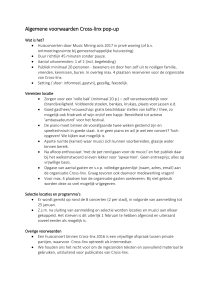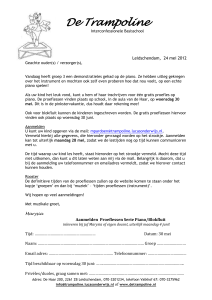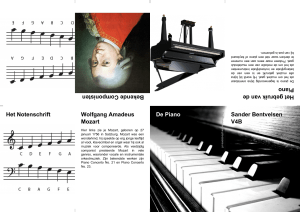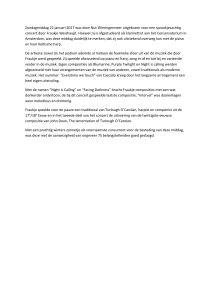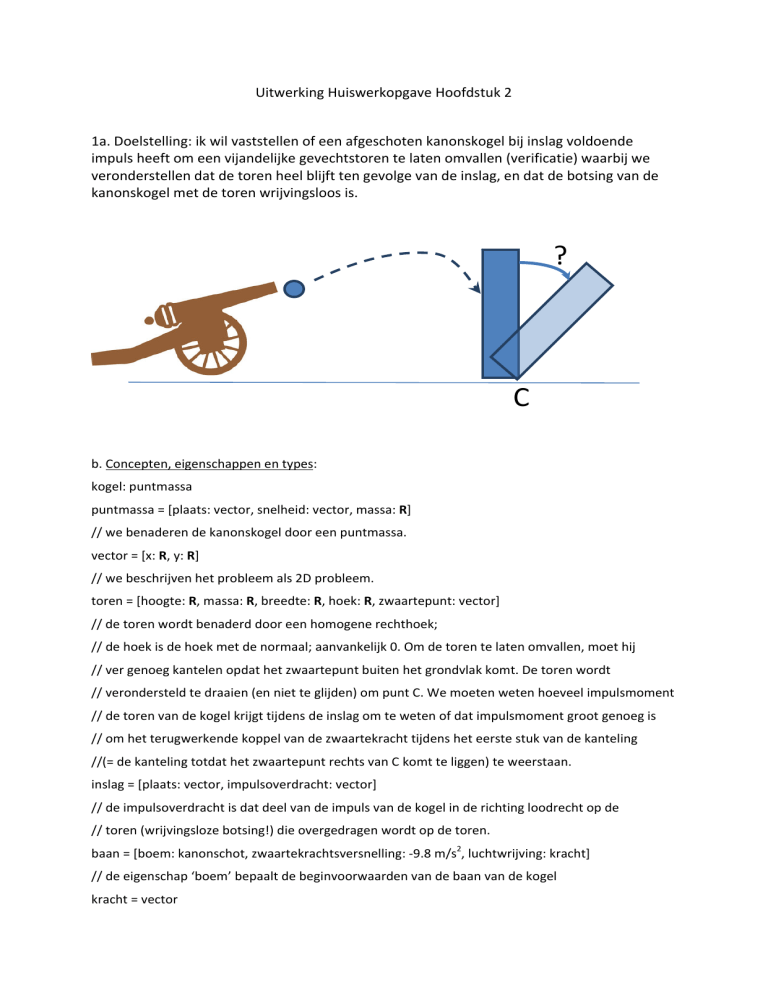
Uitwerking Huiswerkopgave Hoofdstuk 2 1a. Doelstelling: ik wil vaststellen of een afgeschoten kanonskogel bij inslag voldoende impuls heeft om een vijandelijke gevechtstoren te laten omvallen (verificatie) waarbij we veronderstellen dat de toren heel blijft ten gevolge van de inslag, en dat de botsing van de kanonskogel met de toren wrijvingsloos is. ? C
b. Concepten, eigenschappen en types: kogel: puntmassa puntmassa = [plaats: vector, snelheid: vector, massa: R] // we benaderen de kanonskogel door een puntmassa. vector = [x: R, y: R] // we beschrijven het probleem als 2D probleem. toren = [hoogte: R, massa: R, breedte: R, hoek: R, zwaartepunt: vector] // de toren wordt benaderd door een homogene rechthoek; // de hoek is de hoek met de normaal; aanvankelijk 0. Om de toren te laten omvallen, moet hij // ver genoeg kantelen opdat het zwaartepunt buiten het grondvlak komt. De toren wordt // verondersteld te draaien (en niet te glijden) om punt C. We moeten weten hoeveel impulsmoment // de toren van de kogel krijgt tijdens de inslag om te weten of dat impulsmoment groot genoeg is // om het terugwerkende koppel van de zwaartekracht tijdens het eerste stuk van de kanteling //(= de kanteling totdat het zwaartepunt rechts van C komt te liggen) te weerstaan. inslag = [plaats: vector, impulsoverdracht: vector] // de impulsoverdracht is dat deel van de impuls van de kogel in de richting loodrecht op de // toren (wrijvingsloze botsing!) die overgedragen wordt op de toren. baan = [boem: kanonschot, zwaartekrachtsversnelling: ‐9.8 m/s2, luchtwrijving: kracht] // de eigenschap ‘boem’ bepaalt de beginvoorwaarden van de baan van de kogel kracht = vector kanonschot = [ mond: vector, snelheid: R, hoek: {0 … π/2}] // een kanon geeft een snelheid aan een kanonskogel in grootte (R) en richting; de mond van de loop (eigenschap ‘mond’) is het beginpunt van de baan. omval: {true, false} // dit is een atomair concept (=geen eigenschappen) dat de verificatie uitkomst van ons model voorstelt Relaties (alle ariteiten zijn 1): kogel volgt baan
toren snijdt geeft impuls aan inslag
bepaalt omval
2. We zoeken een formule van de vorm F ∝ lα Dβ ργ fδ. Hierin is F de kracht; l de lengte van de snaar; D de diameter; ρ de dichtheid; f de frequentie. De dimensies zijn als volgt: F:[MLT‐2], l:[L], D:[L], ρ:[ML‐3], f:[T‐1]. Per dimensie levert dit de vergelijkingen: M: 1 = γ L: 1 = α + β ‐3γ T: ‐2 = ‐δ De oplossingen zijn γ = 1 en δ = 2 en α + β = 4. We hebben dus een vergelijking te weinig. Daarom proberen we eerst een alternatieve aanpak: we gaan op zoek naar een formule die de voortplantingssnelheid v uitdrukt in F en ρD2 (de massa per lengte eenheid), en gebruiken vervolgens dat v = 2lf voor de grondtoon (=1 buik tussen twee knopen). We schrijven v = (F)μ(ρD2)ν, met als dimensies V:[LT‐1], F:[MLT—2], ρl2: [ML‐1]. Dit levert op: M: 0 = μ + ν L: 1 = μ ‐ ν T: ‐1 = ‐2μ De oplossingen zijn nu wel eenduidig bepaald: μ = ½ ; ν = ‐ ½ . Dus v=c √F/(ρD2), en dus 2lf = c √F/(ρD2), waarbij c een eenheid‐loze constante is. Ga na dat dit equivalent is met F=4cl2D2ρf2 , ofwel α = β = 2. De eenheid‐loze constante c heeft waarde 1.0; dat vind je bijvoorbeeld door één snaar experimenteel te testen of door een meer gedetailleerde fysische beschouwing. Dus de gevraagde formule is F=4l2D2ρf2. b. Als je echt een piano wil modelleren, kijk je bijvoorbeeld op http://www.music.mcgill.ca/~gary/618/week7/piano.html. Wat onze opgave betreft: een globale berekening zou met ‘gemiddelde’ snaren kunnen rekenen, bijvoorbeeld één snaar voor elk van de drie gedeeltes van de piano (laag, midden, hoog). De uitkomst zal dan echter makkelijk een factor 10 of meer fout kunnen zijn: dat komt omdat de lengte en de frequentie kwadratisch in de formule voorkomen: de hoogste snaren hebben verhoudingsgewijze een veel grotere bijdrage. Een preciezere berekening moet de kracht voor elk van de snaren uitrekenen, en die krachten bijelkaar tellen. Je moet dan rekening houden met de regel dat de frequentieverhouding tussen twee opvolgende tonen op een piano gelijk is, en wel x met x87 = 4200 / 25 = 168, waar 4200 en 25 the hoogste en laagste frequenties zijn (in Hz) van piano tonen. Dus x=87√168 ofwel x ≅ 1.06 (de precieze waarde is 12
√2: er zitten immers 12 gelijke intervallen, elk van een zogenaamde kleine secunde in een octaaf; een octaaf is de verhouding tussen een toon en de toon met dubbele frequentie). Als je je de uitleg van de gekwantiseerde uitdrukkingen (Engels: quantised expressions) begrepen hebt, kun je hier klikken voor een uitwerking in ACCEL van een model waarin een schatting wordt gemaakt van de totale kracht, waarbij bij benadering wordt rekening gehouden met de variërende eigenschappen van de snaren over het toetsenbord. Speel met het aantal toetsen en de frequentie van de laagste toon, en verbaas je over de effecten van deze grootheden op de totale kracht op het frame (de kracht wordt gegeven in tonnen, 1 ton = 10000 N)! Als je je (nog) niet vertrouwd voelt met de aanpak met gekwantiseerde expressies en/of met ACCEL kan het ook (zij het wat omslachtiger) in MS‐EXCEL. Een uitwerking vind je in deze EXCEL worksheet. c. Het helpt het meeste om l, D, of f omlaag te brengen: kortere snaren hebben echter een kleinere massa en een kleinere uitwijking, hebben dus minder kinetische energie, geven dus zachter geluid; dunnere snaren zullen sneller breken, en een piano lager stemmen is muzikaal ongewenst. Minder effectief is het om ρ te reduceren, maar er is vast wel eens geëxperimenteerd met piano’s met aluminium of kunststof snaren. Een ideale piano zou snaren van spinrag (kleine D, kleine ρ) hebben! (Ideaal voor spinragtime muziek ;‐). Elaboration Assignmet Chapter 2 1a. Purpose: I want to assess if a fired cannon ball, at impact, has enough momentum to make an enemy’s turret topple (verification). We assume that the turret stays in one part at impact, and the collision between the cannon ball and the turret is frictionless. ? C
b. Concepts, properties and types: cannon ball: point mass point mass = [location: vector, velocity: vector, mass: R] // we approximate the cannon ball by a point mass, ignoring its rotation. vector = [x: R, y: R] // we develop a 2D description of the problem. turret = [height: R, mass: R, width: R, angle: R, centreOfGravity: vector] // the turret is approximated by a homogenous rectangle; // the angle is the angle between the axis of the turret and the normal, initially 0. // To have the turret topple it must deviate enough to have the centre of gravity extend beyond the // support plane. The turret is supposed to rotate (not to glide) round point C. // We need to know the amount of angular momentum is transferred at the moment of impact // to know if this angular momentum suffices to compensate the counterachting torque due // to gravity during the first part of the toppling (=the part of the toppling until the centre // of gravity ends up right from C). impact = [location: vector, momentumTransfer: vector] // the momentum transfer is the part of the cannon ball’s momentum perpendicular to the turret // (ignore friction!), transferred to the turret. trajectory = [boom: cannonShot, gravityAcceleration: ‐9.8 m/s2, airFriction: force] // the property ‘boom’ determines the initial conditions of the cannon ball’s trajectory force = vector cannonShot = [ mouthLocation: vector, velocity: R, angle: {0 … π/2}] // a cannon transfers a speed to a cannon bal in magnitude (R) and direction ({0 … π/2}); the location of the mout the the cannon barrel (property ‘mouthLocation’) is the starting point of the trajectory. fall: {true, false} // this is an atomic concept (=no properties) which represents the verification outcome of our model. Relations (all arities are 1): cannon ball follows trajectory turret
intersects
transfers momentum to impact determines fall
2. We look for a formula in the form F ∝ lα Dβ ργ fδ. Here, F is the force; l is the string length; D is the diameter; ρ is the density; f is the frequency. The dimensions are as follows: F:[MLT‐2], l:[L], D:[L], ρ:[ML‐3], f:[T‐1]. For each dimension, we obtain the equations: M: 1 = γ L: 1 = α + β ‐3γ T: ‐2 = ‐δ Solutions are γ = 1 en δ = 2 and α + β = 4. Aparently, we miss one equation. Therefore we first try an alternative approach: we look for a formula relating the propagation speed v to F and th emass per unit length, and next use v=2lf for the ground tone (=1 vibration maximum in between two nodes). We write v = (F)μ(ρD2)ν, with di V:[LT‐1], F:[MLT—2], ρl2: [ML‐1]. This gives: M: 0 = μ + ν L: 1 = μ ‐ ν T: ‐1 = ‐2μ The solutions are now uniquely determined: μ = ½ ; ν = ‐ ½ . So v=c √F/(ρD2), and therefore 2lf = c √F/(ρD2), where c is a unit‐less constant. Verify that this result is equivalent with F=4cl2D2ρf2 , or α = β = 2. The uni‐less constant c has value 1.0; this is found for example by empirically testing one string, or by doing a more detailed physical derivation of the formula. So the formula we need is F=4l2D2ρf2. b. If you want to model a piano to much detail, you may take a look at http://www.music.mcgill.ca/~gary/618/week7/piano.html. For the current assignment: a very global approach could work with ‘average’ strings, for instance one string for each of three parts of the keyboard (low, middle, high). The result, however, will be very far off (a factor 10 or more). This is because length and frequency occur quadratically in the formula: the few highest strings have a super proportional contribution to the result. A more accurate attempt should calculate the force for each string separately, and add all forces together. You should take into account that the frequancy ratio between two subsequent tones on the piano is equal for all tones, namely x with x87 = 4200 / 25 = 168, where 4200 and 25 are the highest and lowest frequencies of pinao tones (in Hz). So x=87√168 or x ≅ 1.06 (the precise value is 12√2: indeed, there are 12 equal intervals, each of a so‐called minor second, in one octave; one octave is the ratio between a tone and the tone with double frequency). If you have understood the explanation of quantised expressions, you can click here for an elaboration, in ACCEL, of a model thatestimates the total force, where varying properties of strings over the piano keyboard are approximately taken into account. Play with the number of keys and the lowest frequency, and be astonished of their effect on the total force on the frame (the force is given as a dimensional quantity, expressed in tons, 1 ton = 10000 N)! In case you are not (yet) familiar with quantised expressions and/or with ACCEL, the model can also be made (albeit with considerably more effort) in MS‐EXCEL. An elaboration is found in this EXCEL worksheet. c. It is most effective to reduce l,D or f: these occur quadratically in the formula. Shorter strings, however, have smaller mass and therefore produce less volume; thinner strings will break more easily (they cannot withstand the tension), and lower tuning is not acceptable from a musical point of view. Reducing ρ works, but is less effective: expreiments may have been done with piano’s with aluminum or plastic strings. The ideal piano would use strings made of spider’s cobweb!


